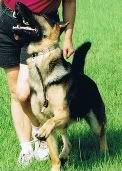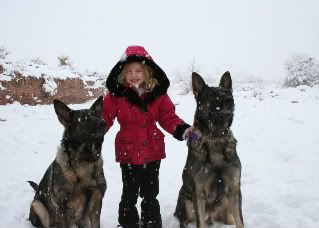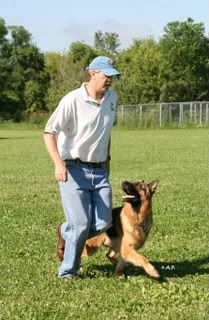 Re: American Line or German Line????
[Re: Beth Fuqua ]
#127723 - 02/04/2007 01:20 PM Re: American Line or German Line????
[Re: Beth Fuqua ]
#127723 - 02/04/2007 01:20 PM |
Webboard User
  
Reg: 11-20-2006
Posts: 1002
Loc:
 Offline Offline |
|
"doesn't appear to be trying to learn anything about it"
um, I've been asking (Susan or anyone else) continuously for explanations on why these dogs are shaped this way. I must've asked at least 4 times since this thread started, and so far, not a single answer. All Susan did was tell me that I was using the wrong terminology (fine, I won't say roach anymore) but she didn't even try to answer my question.
"some internet pictures" - yes, from dogs who won big SV competitions under German judges. That's why I'm using them as examples, they're not just random internet pictures.
I assume that because they've won such prestigious competitions, that they conform to SV standards. I'm trying to find what the SV considers an excellent specimen of a German shepherd so that we can base our discussions on the same thing.
I'm really sorry I called the dogs deformed. I see now that it was a stupid thing to say and that it could offend people who like these dogs. Please, don't hold it against me, I'll try to be less insulting.
As for my not having any experience or wisdom in the matter, that's exactly why I'm asking all these questions!! If I knew why these dogs are the way they are, I wouldn't be here trying to find answers!
I'm just using basic logic to figure this out. Wolves (probably the absolute best in endurance and working ability with the most drastic selective pressure for good health and structure) are not shaped anything like these dogs.
Working breeds selected only for working ability (like border collies, working line shepherds, other herding breeds) are also not shaped anything like that.
The first time I saw an American show shepherd, I thought the dog was deformed. I've since learned that breeders intentionally breed for that, so I don't go around asking American show breeders why their dogs are shaped the way they are.
The first time I saw a German show dog, I also thought it had a problem with its back. It was only after looking at pictures and videos of sieger shows in Germany (like the ones Ed posted on the Leerburg website) that I realized that again, this style was intentional.
All I want to know is why?
Again, sorry for using the word "deformed" and "roach".
So to rephrase my question, why is this... "unique" structure, found nowhere else in the dog/wolf world, sought after by show breeders? Is it all just style and taste like the American show shepherds, or is there a good reason for it?
Please, I just want information on this topic. The last thing I want is to start some kind of fight with show breeders (I think Ed does a pretty good job of that on his site anyway, lol).
I certainly don't have the experience with shepherds to get into a real discussion anyway, I'm just looking for some kind of explanation from a show breeder or enthusiast or expert himself/herself.
Thanks 
|
 Top Top
|
 Re: American Line or German Line????
[Re: Yuko Blum ]
#127729 - 02/04/2007 01:43 PM Re: American Line or German Line????
[Re: Yuko Blum ]
#127729 - 02/04/2007 01:43 PM |
Webboard User
  
Reg: 10-18-2006
Posts: 1725
Loc: Las Vegas Nevada
 Offline Offline |
|
Yuko,
I understand what you are getting at and I think overall you will have some people who think the showline is what a Sheperd is supposed to look like and the working line is what a "working dog is supposed to look like, you'll never find a happy medium.When you get around the showline people you'll hear how the working line are bunch of ugly dogs with crazy drives ect... You get around the working line and hear all the bad things the showline has a including the "ugly back structure" I personally like the low angle look and to tell you the truth , I like 'TEMPERAMENT BEST" that is what I look for first and foremost.I have had showlines that were great schutzhund dogs.I have working lines that were great working dog and Schutzhund.But as far as the angle of the Shepherds back, you'll never get a true answer the reason why for the most part, every show I have attended and trials, everyone has an opinion not a fact on why the showline american or german has the roach back or what ever you want to call it.I'm like you with the same questions of" Why"
and honestly the answer is never a fact but preferences and opinions.We have a American GSD"show" here in Vegas coming up.Too bad you couldn't come we could go on a "Quest" 
|
 Top Top
|
 Re: American Line or German Line????
[Re: Angelique Cadogan ]
#127731 - 02/04/2007 01:46 PM Re: American Line or German Line????
[Re: Angelique Cadogan ]
#127731 - 02/04/2007 01:46 PM |
Webboard User
  
Reg: 01-23-2006
Posts: 1608
Loc: Cali & Wash State
 Offline Offline |
|
Okay, it is my understanding the roach back dogs were originally bred because the breeders mistakenly thought this resulted in a stronger backed dog (which is wrong). It is either that, or it was done by the Weinerau kennel on a whim & because they could!!
(The Great & All Powerful Oz Brothers)
I am not an expert on German High Lines or SV conformation shows, so I am going to bow out before I stick my foot even further down my throat)!!
|
 Top Top
|
 Re: American Line or German Line????
[Re: Yuko Blum ]
#127741 - 02/04/2007 02:16 PM Re: American Line or German Line????
[Re: Yuko Blum ]
#127741 - 02/04/2007 02:16 PM |
Webboard User
  
Reg: 02-25-2004
Posts: 559
Loc: Joliet, IL
 Offline Offline |
|
Yuko, In an offering of respect - assuming you are sincere in your interest to learn more, I will go back to your mention (or my imporession) somewhere along this thread that you don't know what the SV is.
Better historians than me please correct me.
The German Shepherd breed was established, as I understand it, in 1899 by Max vom Stephanitz. We own a copy of this book that was originally published in English in 1925 - "The German Shepherd Dog in Word and Pictures. Herr Stephanitz described very specific standards for the Breed, and that was the foundation of the SV, the Koering and testing system.
Over these many years, many (IMO) legitimate debates have developed as to how these original standards have evolved and changed, and how they are being applied to German Shepherd dogs today. IMO, "working" and "show" standards somehow evolved from this, but to some degree coexist in this same system today. As just one example, it is common to see a dog who in my opinion, is less than stellar in the work recieve a KKL1 rating, while it's common in my experience to see a good working dog automatically get a KKL2 rating from a Koermeister. But Yuko - within the SV system, that's inherent to some degree. Koering a dog is a balance between a structural evaluation, a temperament evaluation, and a performance evaluation including titles. And human opinion is involved in this, making the whole subject rather complex. And we haven't even started discussing the migration (replication?) of these standards from Germany into two (or more) very disparate organizations in the US.
My above comments aren't even a good start on this topic in my opinion. Enjoy your dog. If you really want to delve into the history of GSD's to better understand some of the current debates, some intense study is required. On the other hand, if you want to get a pup who provides you the highest potential opportunity for success with SchH - or other sports/jobs, then none of this history really matters - work with a breeder you trust who can help you identify the best pup/dog for your goals. Do what you enjoy. I personally find some of the historic and organizational / evolution stuff quite interesting, but that has nothing to do with my dogs on the field. It's like two separate hobbies.
Beth
|
 Top Top
|
 Re: American Line or German Line????
[Re: Beth Fuqua ]
#127775 - 02/04/2007 11:13 PM Re: American Line or German Line????
[Re: Beth Fuqua ]
#127775 - 02/04/2007 11:13 PM |
Webboard User
  
Reg: 11-20-2006
Posts: 1002
Loc:
 Offline Offline |
|
Thank you very much for your explanation and insight Beth, it's much appreciated!
I guess it was naive of me to expect a simple one-line answer as to why the dogs are bred to look the way they are.
I did some more reading on the SV standards as well as on discussions from the German show people themselves (thanks for the links Susan, and for all your thoughts on the matter!).
While I still believe that there are some flaws and discrepancies in the SV judging and rating system (as Ed writes on the site), I certainly have a great appreciation for the attempts of the SV to maintain a good balance of working ability and structure in the German shepherd.
It would certainly be nice if American show people would put as much effort into their dogs as the Germans do.
Again, thanks for all your imput and your patience in educating me. I realize how frustrating it must be for knowledgeable people such as yourself to deal with ignorant newbies like me, hee hee 
Then again, I find it very enjoyable to read through people's (very) opinionated thoughts on the subject, especially from the experts (such as Ed Frawley).
What can I say, I love this site!
|
 Top Top
|
 Re: American Line or German Line????
[Re: Yuko Blum ]
#127823 - 02/05/2007 12:34 PM Re: American Line or German Line????
[Re: Yuko Blum ]
#127823 - 02/05/2007 12:34 PM |
Webboard User
  
Reg: 02-25-2004
Posts: 559
Loc: Joliet, IL
 Offline Offline |
|
Hi Yuko. I'm glad you found the information helpful, if you indeed wish to explore the history of the breed.
All of this is IMO of course... Understanding the history and current "politics" can be interesting (it is to me anyway), but LOL doen't help much in the "here and now" with a given training issue. And IMO, watching events first hand teaches you more than "book learning" ever could. And getting on the field with a dog teaches you more than "watching events" ever could.
It looks like you are from Canada? I don't know where the GSD National SchH Championship and Sieger Show is being held this year, and I know Canada is a big place. But if you get the chance to go watch, it would be quite an experience for you, I think. Unlike the US, both of these activities take place across the same weekend in Canada, assuming things are planned this year as in recent past years.
We participated with Kimba (German show line female) in the Canadian Sieger Show in 2004 - St. Johns, New Brunswick. She was in the 9 - 12 month conformation class, and she won as she always won back then.  The HIGHLIGHTS and eye openers of this trip for me and Gary is that we saw REAL SchH3 competition work live and up close for the first time. We had seen a few club level trials, but watching a National level SchH3 competition where a world team is selected is beyond belief - for me still. I will never forget it.
And there is a reason why the Sieger Show (conformation) portion is not well attended in terms of entries, especially by US participants. The protection test for working classes has a reputation for being tough. I think that's what the test SHOULD be like regardless of country. I respect a VA show rating earned in Canada way more than I respect said rating at the US based Sieger Shows. (Germany is a different story, and I can't speak to any other countries and how they have implemented the SV system to have an opinion about how VA ratings are awarded)
Mean time, I will put in another recommendation for SV judge Herr Dieter Oeser. I have presented dogs under him twice for conformation, and have observed the breed surveys he has been responsible for at both events. He has earned my respect for his fairness and honesty, and absence of politics in the ring and on the field. He presided over a conformation show and breed survey this past weekend at Carolina Schutzhund Club (Lewis Lundy in SC). I wish I could have been there. He is strict in his interpretation of the breed standard, but is not biased for/against working line dogs. Several very nice working line GSDs recieved KKL1 ratings in their breed surveys, which were on Sunday. One working line male in the working male conformation class on Saturday recieved SG-1, but during the critique Herr Oeser pointed out the technicality (dog got first breed survey on Sunday) that had the dog already had a breed survey, he would have given a V Rating.
I realize that the vast majority here either don't have GSDs to begin with (have other working breeds), and even if they do, may not care about this system at all - understandable. To the degree that folks in the US are trying to promote fair application of the SV standards in the US, this is the type of judging we need to promote, IMO. So there you have it - another shameless plug for Herr Oeser! If anyone looking for a fair SV judge would like to contact him regarding a club event - I don't know how personally, but I have become friends with a woman here in the US who often translates for him. PM me if you are interested and I can arrange to put you in touch. (I think these judges are limited by the SV in how many events they can judge here, so plan ahead).
Hope this is helpful to someone. And if it's deemed inappropriate - please do an admin delete.
Thanks,
Beth
|
 Top Top
|
 Re: American Line or German Line????
[Re: Beth Fuqua ]
#127859 - 02/05/2007 03:44 PM Re: American Line or German Line????
[Re: Beth Fuqua ]
#127859 - 02/05/2007 03:44 PM |
Webboard User
  
Reg: 01-23-2006
Posts: 1608
Loc: Cali & Wash State
 Offline Offline |
|
Yuko,
I'm glad the links I provided were helpful!
|
 Top Top
|
 Re: American Line or German Line????
[Re: Yuko Blum ]
#127867 - 02/05/2007 07:15 PM Re: American Line or German Line????
[Re: Yuko Blum ]
#127867 - 02/05/2007 07:15 PM |
Webboard User
 
Reg: 10-18-2006
Posts: 353
Loc: Jacksonville, FL, U.S.A.
 Offline Offline |
|
Yuko,
My favorite (perhaps because I agree with it :grin  article on GSD structure is the series of articles by Linda Shaw. The USA (United Schutzhund Clubs of America), to their credit, has been reprinting the articles in a series in their magazine begining a few issues ago. You can also read Shaw's articles online at: http://www.shawlein.com/The_Standard/Index_Page/Index_Page.htm
Here's her definition of roach (my emphasis): " A true roach is any convex (upward) curvature of the spine. It doesn’t really matter if it starts before the withers, after the withers, in the upper or lower back, or is higher or lower than the withers. If the spine is arched anywhere along its length, it’s roached, although the roach can certainly vary in severity. A dog straining at the leash can appear roached, but may not be. The rear is driving forward and the front is stationary; something has to give. However, if the dog displays a curvature when free standing, posed or not, and when moving freely at the trot, it’s roached."
My take on her discussion of the back is that a roach does not help a dog work. At best, it's neutral. At worst, it makes the trotting gait less efficient and reduces stamina.
The complete series of articles is well worth reading (again, a biased opinion!)

Parek |
 Top Top
|
When purchasing any product from Leerburg Enterprises, Inc. it is understood
that any and all products sold by Leerburg Enterprises, Inc. are sold in Dunn
County Wisconsin, USA. Any and all legal action taken against Leerburg Enterprises,
Inc. concerning the purchase or use of these products must take place in Dunn
County, Wisconsin. If customers do not agree with this policy they should not
purchase Leerburg Ent. Inc. products.
Dog Training is never without risk of injury. Do not use any of the products
sold by Leerburg Enterprises, Inc. without consulting a local professional.
The training methods shown in the Leerburg Ent. Inc. DVD’s are meant
to be used with a local instructor or trainer. Leerburg Enterprises, Inc. cannot
be held responsible for accidents or injuries to humans and/or animals.
Copyright 2010 Leerburg® Enterprises, Inc. All rights reserved. All photos and content on leerburg.com are part of a registered copyright owned by Leerburg Enterprise, Inc.
By accessing any information within Leerburg.com, you agree to abide by the
Leerburg.com Privacy Policy and Terms of Use.
 Previous Topic
Previous Topic Index
Index Next Topic
Next Topic













 Top
Top






